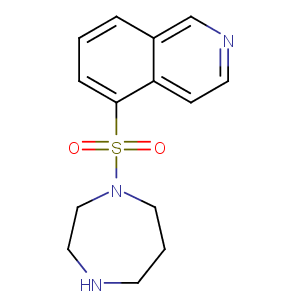Fasudil
| Code | Size | Price |
|---|
| TAR-T1606-5mg | 5mg | £111.00 | |||||||||||||||||||||||||||||||||||||||||||||||||||||||||||||||||||||||||||||||||||||||||||||||||
| Special offer! Add £1 to your order to get a TargetMol CCK-8 Kit. Read more here. | |||||||||||||||||||||||||||||||||||||||||||||||||||||||||||||||||||||||||||||||||||||||||||||||||||
Quantity:
| TAR-T1606-10mg | 10mg | £118.00 | |||||||||||||||||||||||||||||||||||||||||||||||||||||||||||||||||||||||||||||||||||||||||||||||||
| Special offer! Add £1 to your order to get a TargetMol CCK-8 Kit. Read more here. | |||||||||||||||||||||||||||||||||||||||||||||||||||||||||||||||||||||||||||||||||||||||||||||||||||
Quantity:
| TAR-T1606-25mg | 25mg | £142.00 | |||||||||||||||||||||||||||||||||||||||||||||||||||||||||||||||||||||||||||||||||||||||||||||||||
| Special offer! Add £1 to your order to get a TargetMol CCK-8 Kit. Read more here. | |||||||||||||||||||||||||||||||||||||||||||||||||||||||||||||||||||||||||||||||||||||||||||||||||||
Quantity:
| TAR-T1606-50mg | 50mg | £173.00 | |||||||||||||||||||||||||||||||||||||||||||||||||||||||||||||||||||||||||||||||||||||||||||||||||
| Special offer! Add £1 to your order to get a TargetMol CCK-8 Kit. Read more here. | |||||||||||||||||||||||||||||||||||||||||||||||||||||||||||||||||||||||||||||||||||||||||||||||||||
Quantity:
| TAR-T1606-100mg | 100mg | £222.00 | |||||||||||||||||||||||||||||||||||||||||||||||||||||||||||||||||||||||||||||||||||||||||||||||||
| Special offer! Add £1 to your order to get a TargetMol CCK-8 Kit. Read more here. | |||||||||||||||||||||||||||||||||||||||||||||||||||||||||||||||||||||||||||||||||||||||||||||||||||
Quantity:
Prices exclude any Taxes / VAT
Overview
Regulatory Status: RUO
Shipping:
cool pack
Storage:
-20°C
Images
Documents
Further Information
Bioactivity:
Fasudil is a potent inhibitor of ROCK1, PKA, PKC, and MLCK.
CAS:
103745-39-7
Formula:
C14H17N3O2S
Molecular Weight:
291.369
Pathway:
Cytoskeletal Signaling|Membrane transporter/Ion channel|Chromatin/Epigenetic|Stem Cells|Cell Cycle/Checkpoint|Metabolism|Autophagy|Tyrosine Kinase/Adaptors
Purity:
0.98
SMILES:
O=S(=O)(N1CCCNCC1)c1cccc2cnccc12
Target:
PKA|ROCK|Autophagy|Calcium Channel|PKC|Serine/threonin kinase
References
Negoro N, et al. The kinase inhibitor fasudil (HA-1077) reduces intimal hyperplasia through inhibiting migration and enhancing cell loss of vascular smooth muscle cells. Biochem Biophys Res Commun. 1999 Aug 19;262(1):211-5.
Fukushima M, et al. Fasudil hydrochloride hydrate, a Rho-kinase (ROCK) inhibitor, suppresses collagen production and enhances collagenase activity in hepatic stellate cells. Liver Int. 2005 Aug;25(4):829-38.
Asano T, et al. Mechanism of action of a novel antivasospasm drug, HA1077. J Pharmacol Exp Ther. 1987 Jun;241(3):1033-40.
Asano T, et al. Vasodilator actions of HA1077 in vitro and in vivo putatively mediated by the inhibition of protein kinase. Br J Pharmacol. 1989 Dec;98(4):1091-100.
Ono-Saito N, et al. H-series protein kinase inhibitors and potential clinical applications. Pharmacol Ther. 1999 May-Jun;82(2-3):123-31.



